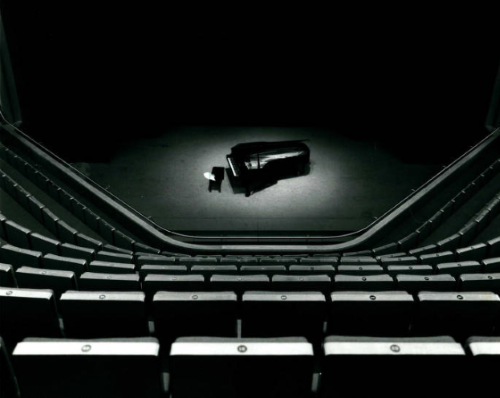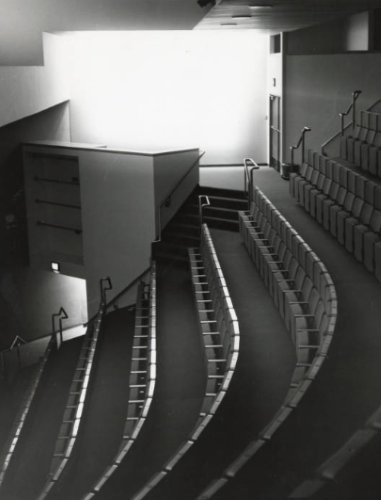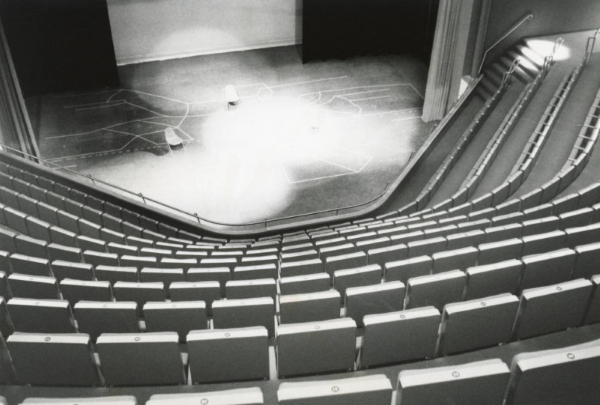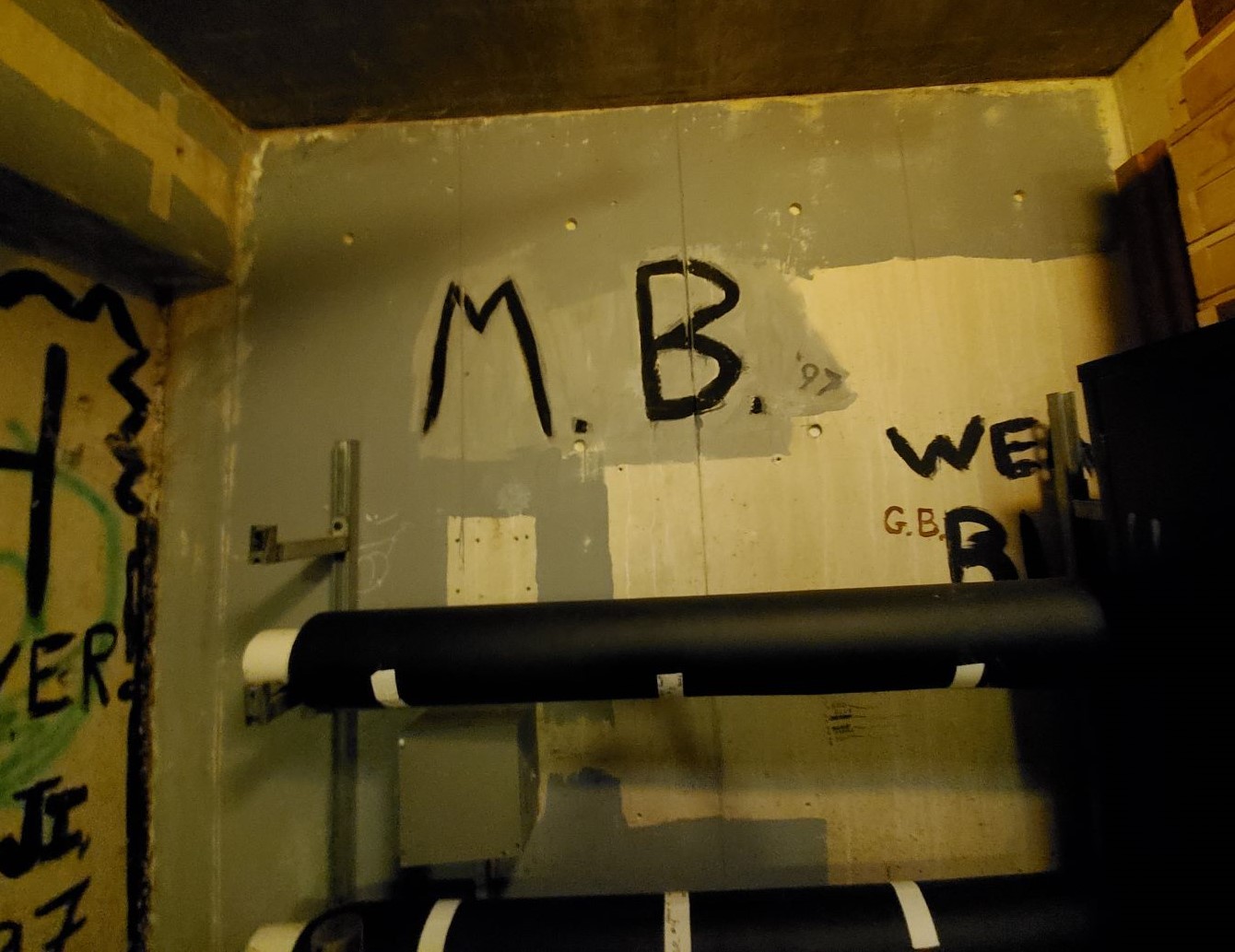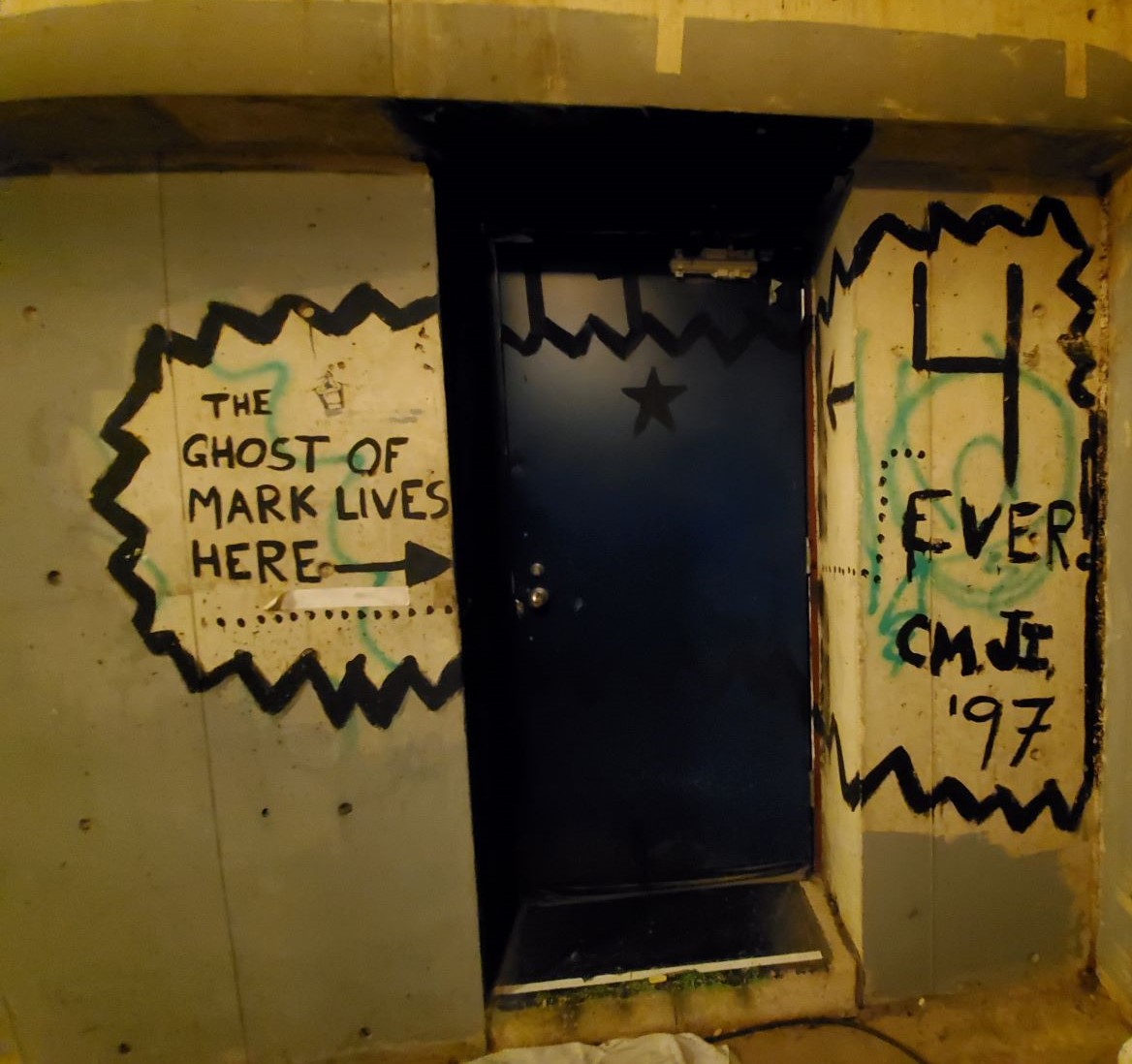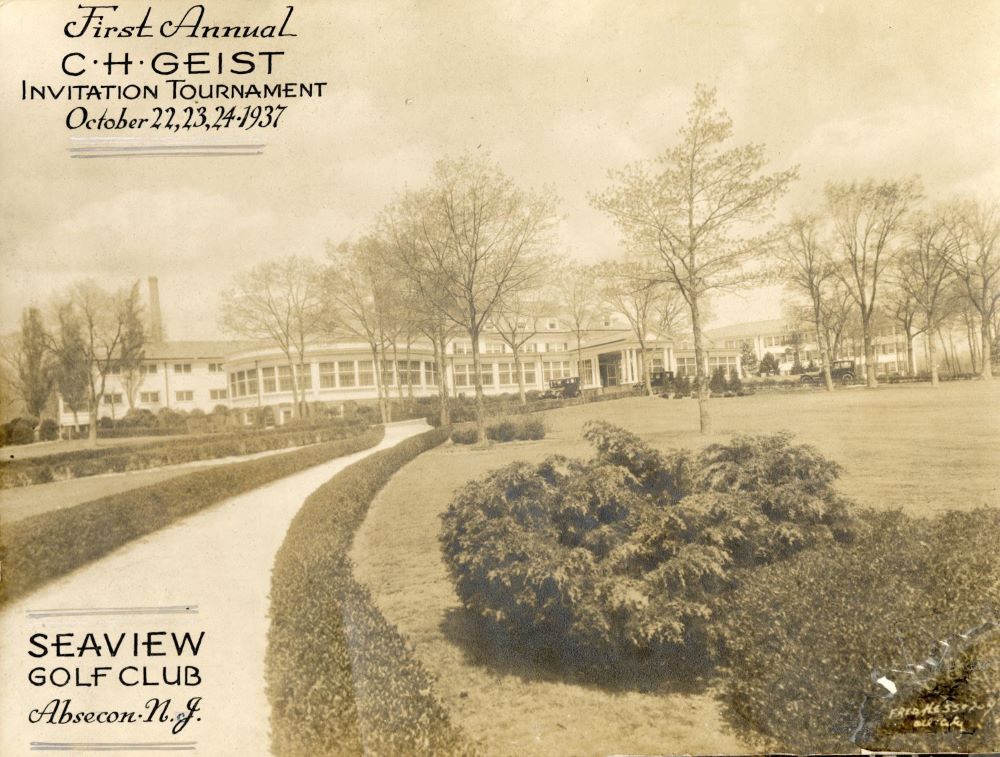Hauntings and Spooky Tales: Urban Legends as Folk Lore
Recorded by Gabrielle Bibus, Gabriella Fiorica, Laurie Melchionne, and Jessica Chamberlain
Like other Universities, Stockton has its share of folklore. Think of the naming of Lakes Fred and Pam. Here we focus on haunted tales. Whether told to frighten newbies, capture the attention of idle students, or just to pass time, these creepy tales have floated around campus for years. They are in circulation as we near our fiftieth anniversary and we record them for posterity. Dear readers, proceed at your own risk.
The PAC is Haunted
Everybody knows the Performing Arts Center. It’sone of Stockton’s notable architectural features. The theater holds 550 audience members
and boasts the largest stage on campus. Yet the space is unsettling.
Maybe it’s the height at which the audience hovers over the stage and orchestra or the dramas that are enacted there. Maybe it’s the fact that the PAC is haunted. Here’s one story.
Amy was a theater major, and she was hanging out with a group of friends on the roof of the PAC. She didn’t say how she got up there. As she and her friends caroused, she noticed a stranger join the group. Standing off to the side, the newcomer wore a black leather jacket, white t-shirt, and jeans. Amy thought, “That guy looks like he stepped out of the sixties.”
The man laughed with the group, enjoying their conversation, but no one noticed him except Amy. On a different night she was back on the roof, and the man appeared again. This time he singled out Amy. He caught her attention, then nodded toward the edge of the roof as if to say “Follow me.” So Amy did. It was sort of like Hamlet on the ramparts. When Amy placed her hand on the roof’s edge, it was as though she pressed PLAY on a video. The man stood on the ledge, smiled at her, then jumped. Amy was horrified and shouted to her friends, but they hadn’t seen anything. Was a ghost reenacting his death for her? Why? No records indicate a suicide in this manner. Amy, of course, hasn’t returned to the roof of the PAC since.
Here’s a second story. There are Shadow People in the PAC. From what theater students tell, there are four entities that call the PAC home: one light spirit and three spirits described as chaotic neutral. The light spirit is good and supportive. The latter three are not mischievous per se; they are just living their supernatural lives, but sometimes they cause trouble.
One day, after a rehearsal with a peculiarly nasty vibe, a group of thespians decided to try to contact the Shadow People. What was causing the bad energy in the auditorium? They sat together on stage and meditated. Immediately it was clear the spirits were NOT happy with the ritual. They seemed to message “Mind your own business. You don’t wanna hear what we’re thinking” and “I’m mad. Get out.” The spirits singled out one actor in particular; they said to the other students, “Tell your friend to stop. When you’re not with him, he’s with us. You’re protecting him. We don’t like him right now.” It was a cryptic message, but clear enough for the actors. They stopped what they were doing and left the theater.
Many theater majors are aware of the PAC’s Shadow People and attribute dark moods to their interference. Yes, theater work comes with its own peculiar dramas and stress, but at one rehearsal, the agitation grew so thick that friends grew ready to curse and fight. This is the doing of the Shadow People. Dark spirits thrive off of negative energy. They pick up on a general tension and amplify it. I mean, really, who would believe that every member of the cast could be in such bad moods?
The Tale of Mark Bolderman and The Experimental Theater
The Experimental Theater, the ET, is a black box theater located beneath the Performing Arts Center. The small space seats 50 to 60 people, depending on the set, and provides an intimate theatrical experience. Even more so than the larger PAC stage, the ET is haunted. Here is the why. The walls of the firehall behind the theater are painted with the ashes of a dead Stockton student.
Pam Hendrick and other theater faculty used to tell this tale. The story still circulates among the students. Professor Hendrick came to the college in 1995. At that same time, student Mark Bolderman returned to finish his theater studies, having taken a leave of absence due to a cancer scare. Mark was talented, funny, and highly respected. He made the most of his time in the theatre program; unfortunately, his cancer returned and he passed away in 1997.
A memorial service was held, and a memorial fund was set up: it paid for new chairs for the theater. That much is factual and easily proven. But the story is also told that one of Mark’s last wishes was for his ashes to be mixed with paint and used to decorate the ET. That way he would be part of the theater forever. Head down to the theater and you can see the black wall yourself.
Strange occurrences take place in the ET. Place your ID on a set-piece on stage and it will disappear, only to be found underneath the lighting board or some other implausible place. Is this Mark, horsing around with his colleagues? For a while, when Pam was about to retire, Mark’s ghost seemed to be laying low. His last connection to the theater community, a respected teacher, was about to leave. Only later, when the program staged She Kills Monsters, did he become active again. The play takes place in 1995, two years before Mark passed away. Perhaps the 90s-inspired music, dialogue and costumes incited him to start hanging around again.
On the backstage firehall, the words “THE GHOST OF MARK LIVES HERE 4EVER” are painted on either side of the door leading to the stage. During performances, actors place their hands on Mark’s wall for a few seconds before going onstage. This seems to help them collect themselves and to boost their energy and confidence.
Do the walls of the Experimental Theater actually contain Mark Bolderman’s ashes? Some students claim that they feel them, gritty to the touch. Others observe that the wall is simply bumpy, the paint uneven. Regardless, Mark’s life and dedication to the theatre program were real, and his legacy lives on. If he is still spending time in the Experimental Theater, Pam says the ET could not ask for a more worthy ghost.
Seaview Hotel
The Seaview Hotel & Golf Club, which first opened its doors in 1914, is haunted. So the stories go. Stockton purchased the property in August 2010 and sold it in April 2018. During the intervening years, resident students experienced many strange incidents. Elevators are said to rise from the basement to the top floor on their own. Two separate tales of suicide by hanging are told: a bride in the basement and a student on the third floor. Several people claim to have seen a little boy playing in the hotel’s hallways, which makes little sense in student housing.
Students reported personal belongings disappearing from their rooms. Was this paranormal activity or human acts of theft? One student, while writing an essay in her room, watched a large Snapple bottle lean sideways on her desk and then slam back upright. What was that? Stress messing with a student’s mind or something more sinister?
Class of 2020 students, some of the last to live at the resort, experienced a remarkable amount of paranormal activity during their year in residence. Two roommates who chose the Seaview because of its haunted reputation interrogated an employee at the front desk, soon after their arrival in September. Were there really ghosts? The employee told the following story.
Once the meeting room area of the Seaview, downstairs, was under construction. As a worker stood on a tall ladder, a woman in an old-fashioned dress approached and asked what he was doing. He made a quick reply, focusing on his work, and didn’t think much of it. Suddenly, when he looked back, she was gone. It spooked him so he checked the security tapes and found there was no one there. He had been alone in the hallway. On the footage he could be seen talking to himself.
Bathrooms were hotspots for paranormal activity at the Seaview. Students report hearing door tapping on repeated occasions despite being alone. One student clearly heard her name called while she was in the shower. She called back but received no response. She then texted her roommates to ask what they wanted, but all three responded that they were on campus at the time. There was no one in the room to call her name.
One dorm room at the Seaview had its own personal ghost which the occupant named Emerson. Emerson would turn an Xbox on and off. Perhaps this can be written off as electrical or technical difficulties in an old building except that often the Xbox would switch out of game mode in the middle of a game to a tv channel, and the channel was always True Crime. Bags of chips also crinkled while the student was in the room. Somehow it’s easy to imagine a ghost who watches TV and eats chips living in a college student’s dorm.
Strange creaking noises and flickering lights were regular occurrences at the Seaview, and some students described the resort as giving off Shining vibes. But not every Seaview resident had such colorful experiences. Now that Stockton no longer owns the resort, new students will no longer confirm or deny the truth of these stories, but select alumni will have their spooky memories.
The Student in the Ceiling
Professor Ken Tompkins tells the following story. He knows it well but is no longer sure of its authenticity. When he is asked to tell the tale, he makes it clear up front, “I’ve come to believe this story is not true. No one else appears to remember it.” It is the story of a student who in the early 70s was discovered living in the ceiling of B-wing.
It was the spring of 1972, right after the college moved from the Mayflower Hotel to the Pomona campus. Only A- through D-wings had been built. Additional wings were under construction. Because of the lack of space, one section of B-wing housed a common area for the office spaces of 55 faculty, crammed together in “landscape offices”—cubicles. Most of the professors hated these offices. They provided little to no privacy. There was always noise in the area, either faculty on typewriters or chatter among faculty and students.
Late at night, the entrance to this common area was locked, but during a long span of time it wasn’t. In slow periods, anyone could gain access, step on a desk, and crawl into the space above the ceiling tiles, if he or she were fit enough.
It was suspected that someone had done so when faculty began arriving in the morning to find papers, neatly stacked the night before, in disorganized piles. Perplexingly, there were footprints on desks. It happened three or four times.
Before long—who says that faculty are slow on the uptake—they suspected that someone was spending time in the crawl space above the tile ceiling. A few professors began hiding under desks at night, hoping to catch the culprit.
Eventually, late one night, staff spotted a ceiling panel being removed from above and a form lowering itself down onto a desk. The miscreant moved around the room for a short while, seemingly searching for food, before he was confronted. Faculty discovered that the student had fashioned a nest area in the far corner of the crawl space where he stored sleeping gear and a few personal belongings.
As Tompkins tells the story, the student wasn’t arrested. Administrators simply gave him a stern warning to desist. This was in the early days, before on-campus housing was built.
Hear Professor Tompkins retell the tale of the Student Living in the Ceiling:
